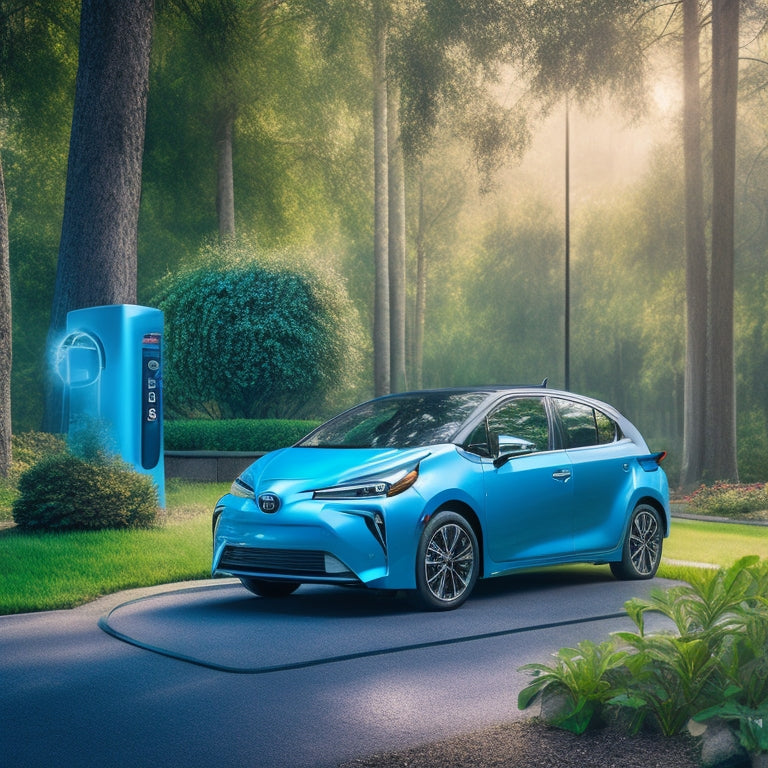
Buzzing With Toyota EVS and Charging Tips
Share
Toyota has entered the electric vehicle market with the bZ4X, a fully electric crossover SUV offering a 250-mile range on a single charge, comfort, and safety features. Understanding charging methods is essential, with Level 1, 2, and 3 options providing varying speeds. Home installation of a Level 2 charger can be done with professional assistance. To optimize charging, locating charging stations is vital, with online resources and mobile apps like PlugShare and ChargeHub available. As the EV landscape continues to evolve, exploring the latest developments in charging infrastructure and etiquette will be key to ensuring a seamless electric vehicle experience.
Key Takeaways
• Toyota's bZ4X electric vehicle offers a 250-mile range on a full charge and is widely available in Toyota's inventory.
• Level 1, Level 2, and Level 3 charging methods provide varying speeds for electric vehicle recharge, with Level 3 being the fastest.
• Home installation of a Level 2 charger can be done with professional assistance for convenient charging.
• Online resources and mobile apps like PlugShare and ChargeHub help locate charging stations for electric vehicle owners.
• Good charging etiquette includes moving your vehicle once fully charged to allow others to use the charging station.
Toyota's Electric Vehicle Lineup
Toyota's inaugural foray into the electric vehicle market is the bZ4X, an all-electric crossover SUV boasting an estimated 250-mile range on a full charge, coupled with a reputation for comfort and safety features, plug-and-play convenience, and widespread availability in Toyota's inventory.
This electric vehicle lineup prioritizes passenger comfort, equipping the bZ4X with premium comfort features to guarantee a smooth ride.
The bZ4X's impressive battery range eliminates range anxiety, allowing drivers to travel up to 250 miles on a single charge.
With its impressive range and comfort features, the bZ4X is an attractive option for those seeking a reliable and comfortable electric vehicle.
Toyota's commitment to quality and innovation is evident in the bZ4X, making it an excellent choice for those entering the electric vehicle market.
Charging Methods Explained
When it comes to replenishing the battery of an electric vehicle, there are three primary charging methods worth exploring, each with its own unique advantages and limitations.
Level 1 charging uses a standard household power outlet, providing a convenient and slow charging process.
Level 2 charging offers faster speeds and is commonly found in commercial parking lots, with some requiring payment.
For the fastest recharge, Level 3 charging is the way to go, ideal for long road trips or emergencies.
Home installation of a Level 2 charger can be done with professional assistance, providing a faster and more convenient charging experience.
Understanding these charging methods can help you make the most of your electric vehicle.
Finding and Using Charging Stations
Many electric vehicle owners rely on a network of charging stations, which are increasingly accessible in metropolitan areas, to replenish their batteries on the go.
When using public charging stations, it's important to practice good charging etiquette, such as moving your vehicle once fully charged to make way for others.
To find charging stations, utilize online resources or mobile apps like PlugShare or ChargeHub. These platforms provide real-time information on station availability, pricing, and reviews.
As the demand for EVs continues to grow, future advancements in charging infrastructure will play a significant role in supporting widespread adoption. Expect to see expanded networks, faster charging speeds, and enhanced user experiences in the years to come.
Frequently Asked Questions
Can I Charge My EV in the Rain or Wet Conditions?
Like a ship weathering a storm, your EV can charge safely in the rain, thanks to waterproof plugs and safety precautions that guarantee a secure connection, safeguarding both you and your vehicle from electrical shock.
Do I Need a Special Electrical System for Home Charging?
When contemplating home charging, it is crucial to evaluate your electrical system's capacity. Circuit upgrades may be necessary to support the increased power demand. Consult with a licensed electrician to determine if upgrades are necessary to guarantee safe and efficient charging.
Can I Charge My EV With a Regular Extension Cord?
Coincidentally, using a regular extension cord for EV charging is not recommended due to cord safety concerns and outlet capacity limitations, which can cause overheating, fires, or electrical shock, emphasizing the importance of dedicated EV charging infrastructure.
Are EV Charging Cables Compatible With All Vehicles?
Not all EV charging cables are universally compatible; cable standards vary, and vehicle adapters may be required for compatibility, emphasizing the importance of verifying compatibility before purchasing or using charging infrastructure.
Can I Tow an EV if It Runs Out of Charge on the Road?
Coincidentally, roadside emergencies can occur; in the event of an EV running out of charge, Roadside Assistance teams can deploy Emergency Protocols, utilizing Flatbed Transport and Recovery Services, often in collaboration with Highway Patrol, to safely transport the vehicle to a charging station.
Related Posts
-

Why Choose Recycled Paper for Earth-Conscious Business?
By choosing recycled paper, you'll greatly reduce your business's environmental impact. You'll lower your carbon foot...
-

What Tax Deductions Apply to Sustainable Building Materials?
You can claim various tax deductions for sustainable building materials, thanks to over 40 federal tax incentives sup...
-

10 Best Energy-Efficient External Hard Drives for Sustainable Offices
When it comes to sustainable offices, you need external hard drives that balance data storage needs with energy effic...


